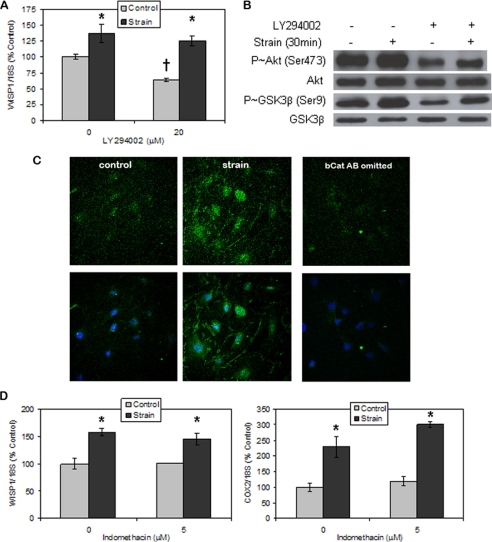FIGURE 4.
Mechanical activation of β-catenin targets does not require PI3-kinase or PGE2 generation. A, WISP1 expression was decreased by treatment with the PI3-kinase inhibitor LY294002 (20 μm), but strain up-regulated WISP1 expression in the presence of LY294002. WISP1 expression at 4 h of strain was evaluated by real-time RT-PCR. Cultures were treated with the inhibitor 1 h prior to strain initiation. The data were normalized to the expression level measured in basal control cells. Data were compiled from two experiments and shown as mean ± S.E. *, significant effect of strain (p < 0.05); †, significant difference between basal and LY294002 control cultures (p < 0.05). B, Western blots showed that strain-induced increases in phospho-GSK3β (P∼GSK3β) (Ser9), and phospho-Akt (P∼Akt) (Ser473) were not blocked by LY294002 treatment. C, CIMC-4 cells were subjected to strain for 15 min, and active β-catenin level was assessed by immunofluorescence (top). Merged images of active β-catenin and nuclear DAPI staining are shown in the bottom. Confocal microscopy showed that LY294002 did not block strain-induced nuclear translocation of active β-catenin. A sample in which the active β-catenin antibody was omitted was also included (right). D, strain up-regulation of WISP1 and COX2 expression was not disrupted by treatment with the cyclooxygenase inhibitor indomethacin (5 μm). WISP1 and COX2 expression at 6 h of strain were evaluated by real time RT-PCR. Cultures were treated with indomethacin 1 h prior to strain initiation. The data were normalized to the expression level measured in basal control cells. Representative data are shown as mean ± S.E., and the experiment was repeated one time. *, significant effect of strain (p < 0.05).

